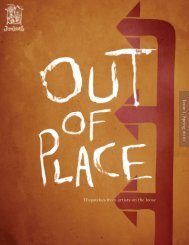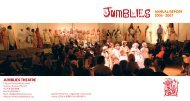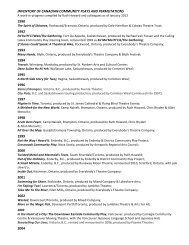Click here for PDF - Jumblies Theatre
Click here for PDF - Jumblies Theatre
Click here for PDF - Jumblies Theatre
Create successful ePaper yourself
Turn your PDF publications into a flip-book with our unique Google optimized e-Paper software.
community arts movement. Corporate philanthropy, with a few notable exceptions like the Laidlaw<br />
Foundation, hasn’t lined up to provide support <strong>for</strong> unglamorous community-based art, and it’s hard to raise<br />
much earned revenue from a mosaic unveiling, a half-year theater project with refugees, a storytelling<br />
program <strong>for</strong> Afghani and Tamil seniors, or a hip-hop workshop <strong>for</strong> impoverished teenagers. Grants are how<br />
most community-based artists earn their daily bread. Although the funding available in Toronto is still far<br />
short of what the artists need and are ready <strong>for</strong>, it has been satisfying to work toward expanding TAC’s<br />
community arts program budget. It has increased by almost 50% from 2003 to 2006, from $561,300 to<br />
$810,000 (Canadian).<br />
I know the importance of grants first-hand, having received my share<br />
of them (rejections, too) throughout my career, sometimes at moments<br />
of acute financial peril. When the Ontario Arts Council gave me a<br />
Works-in-Progress grant to help finish my book “Suddenly They Heard<br />
Footsteps — Storytelling <strong>for</strong> the Twenty-first Century,” I was getting<br />
daily calls from Revenue Canada and Visa <strong>for</strong> unpaid taxes and bills. I<br />
saw the check and nearly wept with relief and jubilation.<br />
“Officer?” said one bemused<br />
applicant, who had served as a<br />
sergeant in the Israeli army, “For<br />
this they call you ‘officer’?”<br />
The most interesting part of my work is conversing with artists and animators and community leaders about<br />
their work. My education as a funder has come out of these conversations, and whatever knowledge I’ve<br />
gained about community arts has come from listening to how the artists themselves describe their<br />
philosophy, practice and passion <strong>for</strong> the work.<br />
Beauty and those Beastly Definitions: What is community arts?<br />
When I began my job, I sought out artists and animators and asked them to explain the term “community<br />
arts.” I quickly encountered a plethora of descriptions and names <strong>for</strong> the field. Even my program, after a<br />
review by an advisory group comprising some renowned artists and theorists, had recently been renamed<br />
Community Arts (from Arts in the Community). The guidelines they developed, after a year’s worth of<br />
discussion, stated: “In essence, Community Arts provides participants ways to experience the arts that are<br />
democratic, interactive, communicative, trans<strong>for</strong>ming, often delightful, and often with a critical edge.” It<br />
struck me at the time that, with all due respect to the advisory group, conveying the “essence” of something<br />
shouldn’t take such an over-abundance of adjectives.<br />
I have since read all the manifestos, newsletters (including the excellent one published by Community Arts<br />
Network), studies and reports I could find. In the 2006 program review the Canada Council <strong>for</strong> the Arts<br />
commissioned <strong>for</strong> its Artists and Community Collaboration Fund, author Laurie McGauley writes:<br />
[T]<strong>here</strong> is a wide spectrum of objectives, approaches, and intentions <strong>for</strong> the work. I think that most of them<br />
[i.e. the community-based artists] would agree that these practices involve artists and communities in some<br />
<strong>for</strong>m of collaborative creation of meaning, of beauty, and/or truth. Beyond that, the languages to describe<br />
and understand these approaches to art making are still evolving with the myriad ways of doing the work.<br />
Perhaps ironically <strong>for</strong> a discipline grounded in communal accomplishment, t<strong>here</strong> doesn’t seem to be much<br />
common ground among its leaders.<br />
T<strong>here</strong> are those who state that community arts must be a work of social and political trans<strong>for</strong>mation. They<br />
prefer to call it “community cultural development,” or “cultural animation.” A new grant program from<br />
Vancouver follows this line of thinking and refers to “art-based community development.” According to<br />
these theorists/practitioners, the artist’s role is to support and lead community members not only in an<br />
artistic production but simultaneously in a process that strengthens their sense of community, develops selfawareness<br />
and enables participants to articulate and achieve social and economic betterment. The measure<br />
of successful cultural animation is found in the changes participants are able to make in their lives through<br />
their involvement with an artistic experience.








